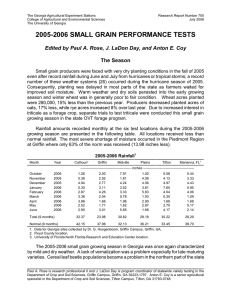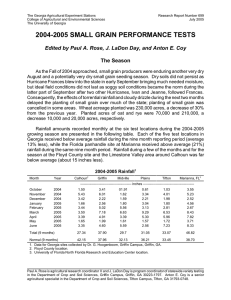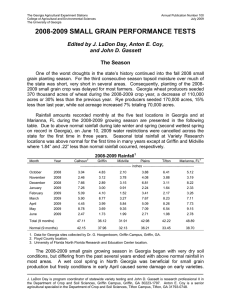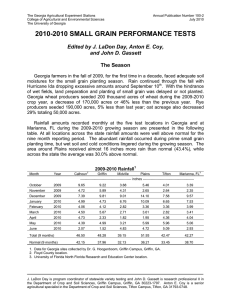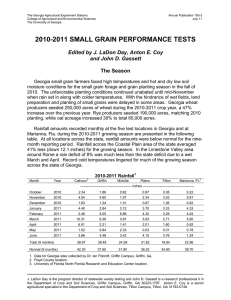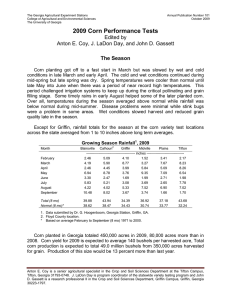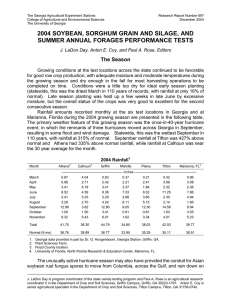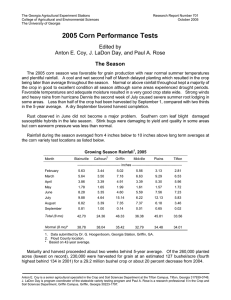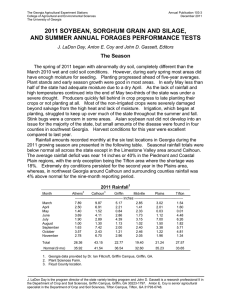The Georgia Agricultural Experiment Stations Research Report Number 694
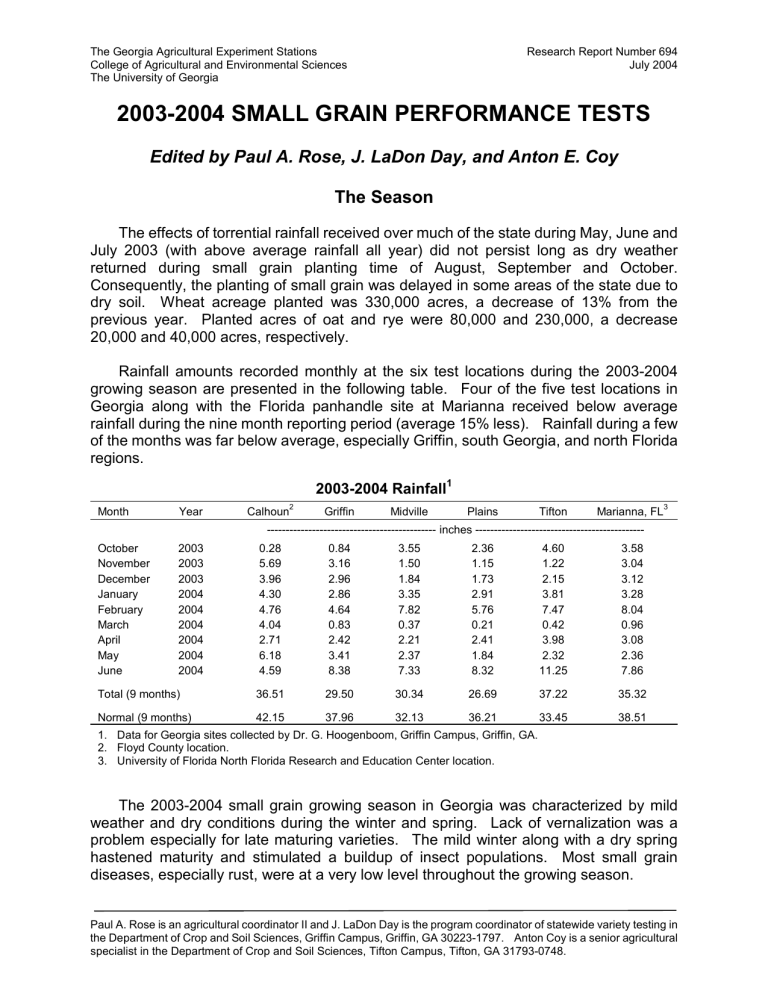
The Georgia Agricultural Experiment Stations
College of Agricultural and Environmental Sciences
The University of Georgia
Research Report Number 694
July 2004
2003-2004 SMALL GRAIN PERFORMANCE TESTS
Edited by Paul A. Rose, J. LaDon Day, and Anton E. Coy
The Season
The effects of torrential rainfall received over much of the state during May, June and
July 2003 (with above average rainfall all year) did not persist long as dry weather returned during small grain planting time of August, September and October.
Consequently, the planting of small grain was delayed in some areas of the state due to dry soil. Wheat acreage planted was 330,000 acres, a decrease of 13% from the previous year. Planted acres of oat and rye were 80,000 and 230,000, a decrease
20,000 and 40,000 acres, respectively.
Rainfall amounts recorded monthly at the six test locations during the 2003-2004 growing season are presented in the following table. Four of the five test locations in
Georgia along with the Florida panhandle site at Marianna received below average rainfall during the nine month reporting period (average 15% less). Rainfall during a few of the months was far below average, especially Griffin, south Georgia, and north Florida regions.
Month
October
November
December
Year
2003
2003
2003
2003-2004 Rainfall
1
Calhoun
2
Griffin Midville Plains Tifton Marianna, FL
--------------------------------------------- inches ---------------------------------------------
0.28 0.84 3.55 2.36 4.60 3.58
3
5.69 3.16 1.50 1.15 1.22 3.04
3.96 2.96 1.84 1.73 2.15 3.12
January
February
March
2004
2004
2004
April
May
2004
2004
June 2004
Total (9 months)
Normal (9 months)
4.30
4.76
4.04
2.71
6.18
4.59
36.51
42.15
2.86
4.64
0.83
2.42
3.41
8.38
29.50
37.96
3.35
7.82
0.37
2.21
2.37
7.33
30.34
32.13
2.91
5.76
0.21
2.41
1.84
8.32
26.69
36.21
1. Data for Georgia sites collected by Dr. G. Hoogenboom, Griffin Campus, Griffin, GA.
3.81
7.47
0.42
3.98
2.32
11.25
37.22
33.45
3.28
8.04
0.96
3.08
2.36
7.86
35.32
38.51
2. Floyd County location.
3. University of Florida North Florida Research and Education Center location.
The 2003-2004 small grain growing season in Georgia was characterized by mild weather and dry conditions during the winter and spring. Lack of vernalization was a problem especially for late maturing varieties. The mild winter along with a dry spring hastened maturity and stimulated a buildup of insect populations. Most small grain diseases, especially rust, were at a very low level throughout the growing season.
Paul A. Rose is an agricultural coordinator II and J. LaDon Day is the program coordinator of statewide variety testing in the Department of Crop and Soil Sciences, Griffin Campus, Griffin, GA 30223-1797. Anton Coy is a senior agricultural specialist in the Department of Crop and Soil Sciences, Tifton Campus, Tifton, GA 31793-0748.
The condition of the small grain crops after the dry conditions was much better than anticipated. The absence of small grain diseases contributed greatly to a good small grain crop. Dry conditions during April and May hastened harvest, although during late
May and June some areas received excessive rainfall which caused 'sprouting in the head' damage. Overall, it was a very good small grain season with high test weight and excellent yield. Total wheat harvested acres decreased by 30,000 less than last season and produced 13% less grain. Oat and rye harvested acres decreased by 20% and 15% from 2003, respectively.
